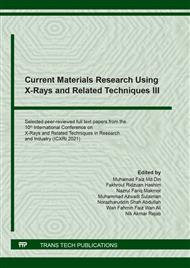p.343
p.348
p.355
p.361
p.367
p.373
p.379
p.385
p.392
Optimization Study of Malachite Green Dye Adsorption by Eggshell Using Response Surface Methodology
Abstract:
Batch adsorption studies for the removal of Malachite green (MG) dye using eggshell was performed. Response Surface Methodology (RSM) was applied to investigate the effect of significant operating parameters on the uptake of the dye molecule. The aim of this study is to determine the potential of eggshell as adsorbent for MG removal and determine the optimum conditions for the adsorption process by using RSM with Central Composite Design (CCD). A 23 full factorial CCD was generated using Design Expert. The effects and interactions of different parameters were evaluated which are contact time (20-60 min), pH (4-8) and adsorbent dosage (0.5-2.0 g). A quadratic model was developed correlating the adsorption variables to the response (percentage of MG removal). Analysis of variance (ANOVA) was used to determine the significant factors on experimental design response. The predicted results obtained were found to be in good agreement (R2 = 0.9388) with the experimental results. The optimum percentage of MG removal was found to be 90.66% with the operating conditions of 40 minutes contact time, pH 6 and 1.25 g of adsorbent dosage. It was suggested that eggshell could be a potential adsorbent in removing MG from aqueous solution.
Info:
Periodical:
Pages:
367-372
Citation:
Online since:
January 2022
Keywords:
Price:
Сopyright:
© 2022 Trans Tech Publications Ltd. All Rights Reserved
Share:
Citation:


